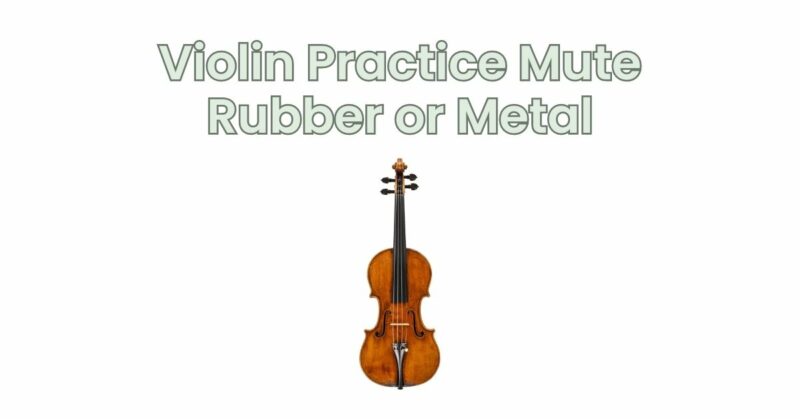When it comes to practicing the violin, using a practice mute can be beneficial for reducing volume and minimizing sound projection. Practice mutes come in different materials, with rubber and metal being the most common options. In this article, we will explore the characteristics of rubber and metal practice mutes, highlighting their advantages and considerations to help you choose the right mute for your practice needs.
Rubber Practice Mute:
Rubber practice mutes are often preferred by violinists for their versatility and ease of use. Here are some key features and considerations:
- Sound Dampening: Rubber practice mutes are effective at dampening the sound and reducing volume. They muffle the vibrations of the strings, resulting in a softer and more muted tone. This is particularly useful for practicing in environments where minimal sound projection is desired.
- Easy Application: Rubber mutes are generally simple to install and remove. They typically slide onto the bridge and stay securely in place during practice. Their lightweight and compact design make them convenient for carrying in your violin case.
- Durability: Rubber mutes tend to be more durable and long-lasting compared to their metal counterparts. They can withstand frequent use without losing their effectiveness or causing damage to the instrument.
- Tone Quality: Rubber mutes can slightly alter the tonal characteristics of the violin. They tend to produce a warmer, softer, and darker sound. While this can be advantageous for practicing certain techniques and passages, it’s important to note that the muted sound may not accurately represent the instrument’s true tonal qualities.
Metal Practice Mute:
Metal practice mutes, typically made of brass or other metals, offer their own set of characteristics and considerations:
- Enhanced Sound Projection Control: Metal mutes provide more control over sound projection compared to rubber mutes. They allow for greater fine-tuning of volume reduction by adjusting the mute’s position on the bridge. This can be advantageous if you need varying degrees of muting during practice sessions.
- Crisp and Clear Tone: Metal mutes generally produce a crisper and clearer sound compared to rubber mutes. They maintain more of the instrument’s natural tone, allowing you to hear the nuances and subtleties of your playing even at reduced volumes.
- Heavier and Secure Fit: Metal mutes tend to be heavier and may provide a more secure fit on the bridge. This can be advantageous if you tend to have more vigorous bowing or if you prefer a mute that stays firmly in place during intense practice sessions.
- Potential Bridge and Instrument Wear: Metal mutes have the potential to cause more wear on the bridge due to their weight and contact with the bridge’s surface. It’s important to monitor the condition of the bridge and ensure that the mute is not causing any damage or deformation over time.
Choosing the Right Mute for Your Practice Needs:
When deciding between a rubber or metal practice mute, consider the following factors:
- Desired Sound Quality: If you prefer a warmer and darker sound, a rubber mute may be more suitable. If you want a clearer and crisper sound with more control over volume reduction, a metal mute may be the better choice.
- Practice Environment: Consider the setting in which you will be practicing. If you need to minimize sound projection significantly, a rubber mute may be more appropriate. If you require more flexibility in adjusting volume levels, a metal mute may better meet your needs.
- Personal Preference: Ultimately, your personal preference and playing style should guide your decision. Experiment with both types of mutes to determine which one feels more comfortable and aligns with your desired practice experience.
Conclusion:
Both rubber and metal practice mutes offer effective volume reduction and can enhance your practice sessions by minimizing sound projection. Rubber mutes provide a warmer and softer tone, while metal mutes maintain a crisper sound with greater control. Consider your desired sound quality, practice environment, and personal preference when choosing between the two. Remember that the ultimate goal of using a practice mute is to facilitate focused and undisturbed practice, allowing you to refine your technique and musicianship.


